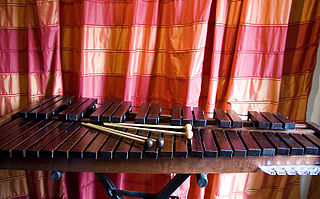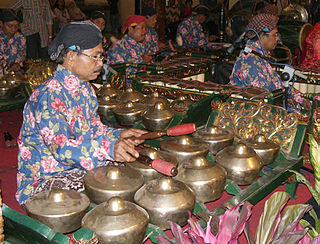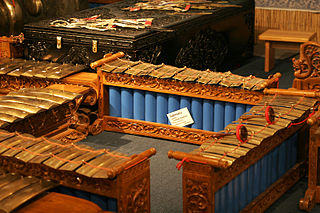Instruments
Jegog instruments have a four-note scale that roughly corresponds to the four pitches of a dominant 7th chord in Western music. All instruments have eight bamboo keys. Some instruments have two keys for each pitch slightly detuned so that the pitches beat when they are played together. Other instruments have a two octave range with four pitches in a low octave and the same four pitches an octave higher. In this case the instrument will be paired with another instrument that is slightly detuned. Taken together the ensemble has a range of five octaves.
Most Jegog ensembles have instruments that have keys that are made of bamboo that are split at one end and then half of the tube is removed. The other end remains intact and functions as a resonator for the split part. The keys are suspended on a wooden frame and struck with mallets (called pangguls), made out of wood or rubber. There are also Jegog ensembles with instruments called Jegog Tingklik. These smaller instruments are used primarily with children. The keys are made of bamboo slats mounted above a resonator box.
Jegog
The lowest instrument in a Jegog ensemble is also called a Jegog. The ensemble gets its name from this instrument. The keys of the Jegog instrument are as long as 3 meters in length and a pitch as low as 60 hertz. The instrument is so large, and the mallets are so heavy that it takes two people to play it. The players crouch on a platform on the top of the instrument and alternate playing the keys. The Jegog instrument has the lowest octave of the ensemble. Each pair of pitches are detuned by as much as 7 hertz. In this octave, that is almost a whole tone. The keys are arranged 1' 2' 3' 4' 1 2 3 4, one being the lowest pitch and 4 being the highest. The four keys on the left are the higher pitches of the detuned pairs and the four on the right are the lower ones.
Melody Instruments
One octave higher than the Jegog is an instrument called the Undir, and an octave above that is the Kuntung. In recent years the Kuntung is often called a Celuluk. The instruments are small enough to be played by one person each. The Undir is still big enough that the player needs to crouch on a platform on the top of it to play it. There are two Undir and two Kuntung. The Undir and Kuntung have the same arrangement of keys as the Jegog but in higher octaves. These five instruments together play the melody (called the bun). Some ensembles have a high pitch flute called a suling that also plays the melody.
Kotekan instruments
Each of the remaining 9 instruments span two octaves and are arranged 1 2 3 4 5 6 7 8 where 5 through 8 is an octave above 1 to 4. The lowest of these instruments, called the Barangan, span the same octaves as the Undir and the Kuntung. The next higher is the Kancil which begins with the octave of the Kuntung and extends an octave higher. The next higher—the highest in the ensemble—is the Suir, likewise, extending one octave higher. There are three Barangan, three Kancil, and three suir.
The Barangan often plays the melody twice as fast as the other melody instruments. Since this is often very fast, the players alternate playing the notes. The Kancil and Suir play interlocking patterns called Kotekan , sometimes the Barangan play these patterns as well. The Barangan are the front line of the ensemble. The center of the three Barangan is the leader of the ensemble. Other players watch the leader for cues and tempo changes.
Instrumentation variations
A smaller version of a gamelan jegog might not have the 2 kuntung and the 3 suir. This smaller ensemble has a longer history than the one outlined above.
If a gamelan jegog is accompanying dance, it may be augmented by kendang (drums), ceng-ceng (cymbals) and tawa-tawa (a beat-keeping small gong).

The xylophone is a musical instrument in the percussion family that consists of wooden bars struck by mallets. Like the glockenspiel, the xylophone essentially consists of a set of tuned wooden keys arranged in the fashion of the keyboard of a piano. Each bar is an idiophone tuned to a pitch of a musical scale, whether pentatonic or heptatonic in the case of many African and Asian instruments, diatonic in many western children's instruments, or chromatic for orchestral use.

The marimba is a musical instrument in the percussion family that consists of wooden bars that are struck by mallets. Below each bar is a resonator pipe that amplifies particular harmonics of its sound. Compared to the xylophone, the timbre of the marimba is warmer and more pure. It also tends to have a lower range than that of a xylophone. Typically, the bars of a marimba are arranged chromatically, like the keys of a piano. The marimba is a type of idiophone.

Gamelan is the traditional ensemble music of the Javanese, Sundanese, and Balinese peoples of Indonesia, made up predominantly of percussive instruments. The most common instruments used are metallophones played by mallets and a set of hand-played drums called kendhang/Kendang, which register the beat. The kemanak and gangsa are commonly used gamelan instruments in Bali. Other instruments include xylophones, bamboo flutes, a bowed instrument called a rebab, a zither-like instrument siter and vocalists named sindhen (Female) or gerong (Male).

As it is a country with many different tribes and ethnic groups, the music of Indonesia itself is also very diverse, coming in hundreds of different forms and styles. Every region have its own culture and art, and as a result traditional music from area to area also uniquely differs from one another. For example, each traditional music are often accompanied by their very own dance and theatre. Contemporary music scene have also been heavily shaped by various foreign influences, such as America, Britain, Japan, Korea, and India.

Gamelan gong kebyar is a style or genre of Balinese gamelan music of Indonesia. Kebyar means "to flare up or burst open", and refers to the explosive changes in tempo and dynamics characteristic of the style.

Joged bumbung is a style of gamelan music from Bali, Indonesia on instruments made primarily out of bamboo. The ensemble gets its name from joged, a flirtatious dance often performed at festivals and parties. This style of Gamelan is especially popular in Northern and Western Bali, but is easily found all over the island. Unlike many styles of Balinese Gamelan which have sacred roles in religious festivals, Joged music is much more secular, and in many ways has become the folk music of Bali. With the rapid rise of tourism in recent decades, Joged music is now often found being performed at hotels and restaurants.

The angklung is a musical instrument from the Sundanese people in Indonesia made of a varying number of bamboo tubes attached to a bamboo frame. The tubes are carved to have a resonant pitch when struck and are tuned to octaves, similar to Western handbells. The base of the frame is held in one hand, while the other hand shakes the instrument, causing a repeating note to sound. Each performer in an angklung ensemble is typically responsible for just one pitch, sounding their individual angklung at the appropriate times to produce complete melodies.
The ugal is an instrument in the Indonesian gamelan orchestra. It is a bronze metallophone played one handed with a small hammer, often in a dance-like manner. There are usually ten keys, giving a maximum range spanning about two octaves. Like the gangsa and gendér, they are suspended over tuned bamboo resonators.

A gangsa is a type of metallophone which is used mainly in Balinese and Javanese Gamelan music in Indonesia. In Balinese gong kebyar styles, there are two types of gangsa typically used: the smaller, higher pitched kantilan and the larger pemade. Each instrument consists of several tuned metal bars each placed over an individual resonator. The bars are hit with a wooden panggul, each producing a different pitch. Duration of sound intensity and sound quality factors are generally accomplished by damping the vibration of the bar with the fingers of the free hand. Balinese gong kebyar gangsas, as with other metallophones in gong kebyar ensembles, are played in neighboring pairs with interlocking, rapid-tempo parts that elaborate on the melody of a piece of music ; these pairs are tuned to be dissonant and create certain wavelengths of sympathetic vibrations to create a shimmering tone that travels long distances. The gangsa is very similar to the old gendér and the saron.

A gendèr is a type of metallophone used in Balinese and Javanese gamelan music. It consists of 10 to 14 tuned metal bars suspended over a tuned resonator of bamboo or metal, which are tapped with a mallet made of wooden disks (Bali) or a padded wooden disk (Java). Each key is a note of a different pitch, often extending a little more than two octaves. There are five notes per octave, so in the seven-note pélog scale, some pitches are left out according to the pathet. Most gamelans include three gendèr, one for sléndro, one for pelog pathet nem and lima, and one for pelog pathet barang.

Gamelan beleganjur is one of the most popular styles of gamelan music in Bali. Its closest Western analogue is probably the Western military band.

The slenthem is an Indonesian metallophone which makes up part of a Javanese gamelan orchestra. The slenthem is part of the gendér family. It consists of a set of bronze keys comprising a single octave: there are six keys when playing the slendro scale and seven when playing the pelog. These keys are suspended by leather cords over individual bamboo tube resonators in a wooden frame, which are cut so that the placement of the bamboo's node causes the functional length of the resonator to be shorter for higher notes. The instrument is played by striking the keys with a mallet, called a tabuh, which has a short handle and a thin wooden disk edged in cloth or rubber. One hand is left free to dampen notes. It is a low-pitched instrument with a softer sound than the saron demung.

Gamelan Sekar Jaya is a Balinese gamelan ensemble located in the San Francisco Bay Area. It has been called "the finest Balinese gamelan ensemble outside of Indonesia" by Indonesia's Tempo Magazine. It performs the music and dance of Bali in many different genres of Balinese gamelan, mainly gamelan gong kebyar, gamelan angklung, gender wayang, and gamelan jegog. Past performances have also featured ensembles playing in other styles as well, including gamelan joged bumbung, kecak, gender batel, gamelan gambuh, genggong, and beleganjur. GSJ has also performed contemporary pieces featuring instruments from the Western tradition.

A gambang, properly called a gambang kayu is a xylophone-like instrument used among people of Indonesia in gamelan and kulintang, with wooden bars as opposed to the metallic ones of the more typical metallophones in a gamelan. A largely obsolete instrument, the gambang gangsa, is a similar instrument made with metal bars.

The bonang is an Indonesian musical instrument used in the Javanese gamelan. It is a collection of small gongs placed horizontally onto strings in a wooden frame (rancak), either one or two rows wide. All of the kettles have a central boss, but around it the lower-pitched ones have a flattened head, while the higher ones have an arched one. Each is tuned to a specific pitch in the appropriate scale; thus there are different bonang for pelog and slendro. They are typically hit with padded sticks (tabuh). This is similar to the other cradled gongs in the gamelan, the kethuk, kempyang, and kenong. Bonang may be made of forged bronze, welded and cold-hammered iron, or a combination of metals. In addition to the gong-shaped form of kettles, economical bonang made of hammered iron or brass plates with raised bosses are often found in village gamelan, in Suriname-style gamelan, and in some American gamelan. In central Javanese gamelan there are three types of bonang used:

Kolintang is a traditional Minahasan percussion instrument from North Sulawesi, Indonesia, consisting of wooden blades arranged in a row and mounted on a wooden tub. Kolintang is usually played in ensemble music. Kolintang in the Minahasan community is used to accompany traditional ceremonies, dance, singing, and music. The wood used to make Kolintang blades is light but strong local wood such as Telur wood, Wenuang wood, Cempaka wood, Waru wood, and the like which have a fiber construction. parallel. Meanwhile, kulintang resonator crates are usually made of hardwood materials such as teak or mahogany.

Gamelan gender wayang is a style of gamelan music played in Bali, Indonesia. It is required for wayang and most sacred Balinese Hindu rituals. The smallest of gamelan ensembles, it requires only two players and is complete at four, the additional instruments doubling an octave above. Like other gamelan genres, it incorporates delicate interlocking melodies and active contrapuntal movement, yet poses unique challenges in technique and composition.

The calung is a type of Indonesian bamboo xylophone originating from Baduy culture and commonly used in Baduy, Bantenese, Sundanese, Banyumasan, and Balinese performances. The calung (instrument) consists of multiple bamboo tubes which are struck at the base to produce a woody sound.

The roneat thung or roneat thum is a low-pitched xylophone used in the Khmer classical music of Cambodia. It is built in the shape of a curved, rectangular shaped boat. This instrument plays an important part in the Pinpeat ensemble. The roneat Thung is placed on the left of the roneat ek, a higher-pitched xylophone. The Roneat Thung is analogous to the ranat thum of Thai.

Gambuh is an ancient form of Balinese dance-drama. It is accompanied by musicians in a gamelan gambuh ensemble.





















